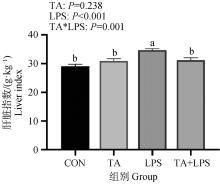





Acta Veterinaria et Zootechnica Sinica ›› 2024, Vol. 55 ›› Issue (6): 2519-2529.doi: 10.11843/j.issn.0366-6964.2024.06.023
• Animal Nutrition and Feeds • Previous Articles Next Articles
Qilu ZHOU1( ), Jinsong LIU2, Chao WU1, Caimei YANG2, Yulan LIU2, Ruiqiang ZHANG1,*(
), Jinsong LIU2, Chao WU1, Caimei YANG2, Yulan LIU2, Ruiqiang ZHANG1,*( )
)
Received:2023-09-15
Online:2024-06-23
Published:2024-06-28
Contact:
Ruiqiang ZHANG
E-mail:zql04102022@163.com;zrq1034@163.com
CLC Number:
Qilu ZHOU, Jinsong LIU, Chao WU, Caimei YANG, Yulan LIU, Ruiqiang ZHANG. Effects of Tannic Acid on Liver Tissue Function, Antioxidant Ability and Inflammatory Response in Lipopolysaccharide Stressed Piglets[J]. Acta Veterinaria et Zootechnica Sinica, 2024, 55(6): 2519-2529.
Table 1
Composition and nutrient levels of basal diets (air-dry basis) %"
| 原料Ingredient | 含量Content | 营养水平Nutrient level | 含量Content | |
| 玉米Corn | 55.00 | 代谢能/(MJ·kg-1) DE | 14.17 | |
| 次粉Wheat middling | 3.50 | 粗蛋白质CP | 20.35 | |
| 磷脂Phospholipid | 2.00 | 赖氨酸Lys | 1.34 | |
| 乳清粉Whey powder | 5.00 | 蛋氨酸+半胱氨酸Met+Cys | 0.77 | |
| 膨化大豆Extruded soybean | 7.30 | 苏氨酸Thr | 0.80 | |
| 豆粕Soybean meal | 18.50 | 钙Ca | 0.95 | |
| 鱼粉Fish meal | 5.00 | 总磷TP | 0.65 | |
| 磷酸二钙Dicalcium phosphate | 1.00 | 有效磷AP | 0.48 | |
| 石灰石Limestone | 1.10 | |||
| 氯化钠NaCl | 0.10 | |||
| 赖氨酸盐酸盐L-Lysine HCl | 0.35 | |||
| DL-蛋氨酸DL-methionine | 0.15 | |||
| 维生素矿物质预混料* Vitamin-mineral premix | 1.00 | |||
| 合计Total | 100.00 |
Table 2
Sequence of primers used in real-time PCR"
| 基因名称 Gene names | 上游引物序列(5′→3′) Forward primer(5′→3′) | 下游引物序列(5′→3′) Reverse primer(5′→3′) | 登录号 Accession number |
| Keap1 | ACGACGTGGAGACAGAAACGT | GCTTCGCCGATGCTTCA | NM_001114671.1 |
| Nrf2 | GCCCCTGGAAGCGTTAAAC | GGACTGTATCCCCAGAAGGTTGT | XM_003133500.5 |
| NQO1 | CATGGCGGTCAGAAAAGCAC | ATGGCATACAGGTCCGACAC | NM_001159613.1 |
| Cu/Zn-SOD | AAGGCCGTGTGTGTGCTGAA | GATCACCTTCAGCCAGTCCTTT | NM_001190422.1 |
| Mn-SOD | GGCCTACGTGAACAACCTGA | TGATTGATGTGGCCTCCACC | NM_214127.2 |
| CAT | AGCTTTGCCCTTGCACAAAC | TCCATATCCGTTCATGTGCCTGTG | NM_214301.2 |
| TLR4 | TGGATTTATCCAGCCAGGACG | GCTGGGACACCACGACAATA | NM_001293317.1 |
| MyD88 | CACCATTCGAGATGACCCCC | CTAGCAATGGACCAGACGCA | NM_001099923.1 |
| NF-κB | TTCTGGACCGCTTGGGTAAC | CACCGTTGGGGTGGTTGATA | NM_001048232.1 |
| NLRP3 | ATTACCCGCCCGAGAAAGG | TCGCAGCAAAGATCCACACAG | NM_004895 |
| IL-6 | TTCAGTCCAGTCGCCTTCT | GTGGCATCACCTTTGGCATCTTCTT | NM_214399.1 |
| TNF-α | ACGCTCTTCTGCCTACTGC | TCCCTCGGCTTTGACATT | NM_214022.1 |
| β-actin | CTACACCGCTACCAGTTCGC | TAGGAGTCCTTCTGGCCCAT | DQ452569.1 |
Table 3
Effect of tannic acid on growth performance in piglets"
| 项目Item | 基础饲粮饲喂组 Basal diet feeding group | 单宁酸饲喂组 Tannin feeding group | P值 P-value |
| 平均初体重/kg Average initial body weight | 8.92±0.40 | 8.98±0.39 | 0.984 |
| 平均末体重/kg Average final body weight | 17.41±0.71 | 18.07±0.75 | 0.853 |
| 平均日采食量/g Average daily feed intake | 505.79±22.17 | 548.53±32.39 | 0.472 |
| 平均日增重/g Average daily gain | 301.01±16.04 | 324.31±15.32 | 0.979 |
| 料重比F/G | 1.69±0.05 | 1.69±0.04 | 0.528 |

Fig. 1
Effects of tannic acid on liver index of piglets challenged by LPS CON. Control group; TA. Tannic acid group; LPS. LPS stress group; TA+LPS. Tannic acid+LPS group. Bars with different small letters mean significant difference(P < 0.05), while with the same or no letter mean no significant difference(P>0.05). The same as below"

| 1 |
NOVAISA K,DESCHÊNEK,MARTEL-KENNESY,et al.Weaning differentially affects mitochondrial function, oxidative stress, inflammation and apoptosis in normal and low birth weight piglets[J].PLoS One,2021,16(2):e0247188.
doi: 10.1371/journal.pone.0247188 |
| 2 |
LIS,TANH Y,WANGN,et al.The role of oxidative stress and antioxidants in liver diseases[J].Int J Mol Sci,2015,16(11):26087-26124.
doi: 10.3390/ijms161125942 |
| 3 | JEZIERNYD,MOSENTHINR,BAUERE.The use of grain legumes as a protein source in pig nutrition: a review[J].Anim Feed Sci Technol,2010,157(3/4):111-128. |
| 4 |
PAYNED E,MARTINN R,PARZYCHK R,et al.Tannic acid inhibits Staphylococcus aureus surface colonization in an IsaA-dependent manner[J].Infect Immun,2013,81(2):496-504.
doi: 10.1128/IAI.00877-12 |
| 5 |
徐树英,谭蔚,张玉苍.香蕉茎秆单宁酸提取纯化及其抗氧化性[J].热带作物学报,2016,37(8):1567-1574.
doi: 10.3969/j.issn.1000-2561.2016.08.020 |
|
XUS Y,TANW,ZHANGY C.Extraction and purification of tannins from banana pseudostem and its antioxidant properties[J].Chinese Journal of Tropical Crops,2016,37(8):1567-1574.
doi: 10.3969/j.issn.1000-2561.2016.08.020 |
|
| 6 | CHOIJ M,HANJ,YOONB S,et al.Antioxidant properties of tannic acid and its inhibitory effects on paraquat-induced oxidative stress in mice[J].Food Sci Biotechnol,2006,15(5):728-734. |
| 7 | BRUSM,DOLINŠEKJ,CENCIČA,et al.Effect of chestnut (Castanea sativa Mill.) wood tannins and organic acids on growth performance and faecal microbiota of pigs from 23 to 127 days of age[J].Bulg J Agric Sci,2013,19(4):841-847. |
| 8 | 徐婷婷,杨智仁,曹沛文,等.包膜单宁酸对断奶仔猪生长性能、肠道形态及抗氧化能力的影响[J].中国畜牧杂志,2021,57(S1):247-252. |
| XUT T,YANGZ R,CAOP W,et al.Effects of enveloped tannins on growth performance, intestinal morphology and antioxidant capacity of weaned piglets[J].Chinese Journal of Animal Science,2021,57(S1):247-252. | |
| 9 |
CIESIELSKAA,MATYJEKM,KWIATKOWSKAK.TLR4 and CD14 trafficking and its influence on LPS-induced pro-inflammatory signaling[J].Cell Mol Life Sci,2021,78(4):1233-1261.
doi: 10.1007/s00018-020-03656-y |
| 10 | 俞晓蓉,代兵,刘金松,等.地衣芽孢杆菌对脂多糖诱导的仔猪肝脏炎症及抗氧化功能的影响[J].微生物学报,2023,63(3):1283-1294. |
| YUX R,DAIB,LIUJ S,et al.Effects of Bacillus licheniformis on lipopolysaccharide-induced liver inflammation and antioxidant function in weaned piglets[J].Acta Microbiologica Sinica,2023,63(3):1283-1294. | |
| 11 | 刘洋,刘翔,李闯,等.饲粮添加水解塔拉单宁酸对断奶仔猪生长性能、血清抗氧化能力和免疫能力的影响[J].动物营养学报,2023,35(4):2175-2183. |
| LIUY,LIUX,LIC,et al.Effects of dietary hydrolyzed Tara tannic acid on growth performance, serum antioxidant capacity and immune capacity of weaned piglets[J].Chinese Journal of Animal Nutrition,2023,35(4):2175-2183. | |
| 12 | 刘英娜,张慧媛,林嘉楠,等.单宁酸对脂多糖诱导小鼠肝损伤的保护作用及机制研究[J].人参研究,2017,29(6):36-39. |
| LIUY N,ZHANGH Y,LINJ N,et al.Protective effect of tannic acid on lipopolysaccharide-induced liver damage in murine and its mechanism[J].Ginseng Research,2017,29(6):36-39. | |
| 13 | CAPPAIM G,WOLFP,PINNAW,et al.Pigs use endogenous proline to cope with acorn (Quercus pubescens Willd.) combined diets high in hydrolysable tannins[J].Livest Sci,2013,155(2/3):316-322. |
| 14 |
SCHIEBERM,CHANDELN S.ROS function in redox signaling and oxidative stress[J].Curr Biol,2014,24(10):R453-R462.
doi: 10.1016/j.cub.2014.03.034 |
| 15 | MAURYAP K,DUAK.Role of oxidative stress in pathophysiology of diseases[M].Singapore:Springer,2020. |
| 16 |
JIANGZ Y,LINY C,ZHOUG L,et al.Effects of dietary selenomethionine supplementation on growth performance, meat quality and antioxidant property in yellow broilers[J].J Agric Food Chem,2009,57(20):9769-9772.
doi: 10.1021/jf902411c |
| 17 |
BEDARDL L,MASSEYT E.Massey.Aflatoxin B1-induced DNA damage and its repair[J].Cancer Lett,2006,241(2):174-183.
doi: 10.1016/j.canlet.2005.11.018 |
| 18 |
GVLÇIN,HUYUTZ,ELMASTAŞM,et al.Radical scavenging and antioxidant activity of tannic acid[J].Arab J Chem,2010,3(1):43-53.
doi: 10.1016/j.arabjc.2009.12.008 |
| 19 | 王思甜,徐朋涛,郑丽云,等.单宁酸对感染猪流行性腹泻病毒仔猪生长性能、肠道屏障功能和抗氧化能力的影响[J].动物营养学报,2023,35(7):4276-4286. |
| WANGS T,XUP T,ZHENGL Y,et al.Effects of tannic acid on growth performance, intestinal barrier function and antioxidant capacity of piglets infected with porcine epidemic diarrhea virus[J].Chinese Journal of Animal Nutrition,2023,35(7):4276-4286. | |
| 20 |
FRANKIAČG T,SALOBIRJ.In vivo antioxidant potential of sweet chestnut (Castanea sativa Mill.) wood extract in young growing pigs exposed to n-3 PUFA-induced oxidative stress[J].J Sci Food Agric,2011,91(8):1432-1439.
doi: 10.1002/jsfa.4328 |
| 21 |
GUPTAM,DEYS,MARBANIANGD,et al.Grape seed extract: having a potential health benefits[J].J Food Sci Technol,2020,57(4):1205-1215.
doi: 10.1007/s13197-019-04113-w |
| 22 |
LOBODAA,DAMULEWICZM,PYZAE,et al.Role of Nrf2/HO-1 system in development, oxidative stress response and diseases: an evolutionarily conserved mechanism[J].Cell Mol Life Sci,2016,73(17):3221-3247.
doi: 10.1007/s00018-016-2223-0 |
| 23 |
SHAWP,CHATTOPADHYAYA.Nrf2-ARE signaling in cellular protection: mechanism of action and the regulatory mechanisms[J].J Cell Physiol,2020,235(4):3119-3130.
doi: 10.1002/jcp.29219 |
| 24 |
BOBILEVI,NOVIKV,LEVII,et al.The Nrf2 transcription factor is a positive regulator of myeloid differentiation of acute myeloid leukemia cells[J].Cancer Biol Ther,2011,11(3):317-329.
doi: 10.4161/cbt.11.3.14098 |
| 25 |
REGGIS,GIROMINIC,DELL'ANNOM,et al.In vitro digestion of chestnut and quebracho tannin extracts: Antimicrobial effect, antioxidant capacity and cytomodulatory activity in swine intestinal IPEC-J2 cells[J].Animals,2020,10(2):195.
doi: 10.3390/ani10020195 |
| 26 |
MENGQ W,GUOT,LIG Q,et al.Dietary resveratrol improves antioxidant status of sows and piglets and regulates antioxidant gene expression in placenta by Keap1-Nrf2 pathway and Sirt1[J].J Anim Sci Biotechnol,2018,9,34.
doi: 10.1186/s40104-018-0248-y |
| 27 |
LIUN,ZHANGG X,NIUY T,et al.Anti- inflammatory and analgesic activities of indigo through regulating the IKKβ/IκB/NF-κB pathway in mice[J].Food Funct,2020,11(10):8537-8546.
doi: 10.1039/C9FO02574J |
| 28 |
ALAMEDDINEJ,GODEFROYE,PAPARGYRISL,et al.Faecalibacterium prausnitzii skews human DC to prime IL10-producing T cells through TLR2/6/JNK signaling and IL-10, IL-27, CD39, and IDO-1 induction[J].Front Immunol,2019,10,143.
doi: 10.3389/fimmu.2019.00143 |
| 29 |
SONGD,ZHAOJ B,DENGW X,et al.Tannic acid inhibits NLRP3 inflammasome-mediated IL-1β production via blocking NF-κB signaling in macrophages[J].Biochem Biophys Res Commun,2018,503(4):3078-3085.
doi: 10.1016/j.bbrc.2018.08.096 |
| 30 |
WUY,ZHONGL M,YUZ R,et al.Anti-neuroinflammatory effects of tannic acid against lipopolysaccharide-induced BV2 microglial cells via inhibition of NF-κB activation[J].Drug Dev Res,2019,80(2):262-268.
doi: 10.1002/ddr.21490 |
| 31 |
MATSUMURAY,KITABATAKEM,OUJI-SAGESHIMAN,et al.Persimmon-derived tannin has bacteriostatic and anti-inflammatory activity in a murine model of Mycobacterium avium complex (MAC) disease[J].PLoS One,2017,12(8):e0183489.
doi: 10.1371/journal.pone.0183489 |
| [1] | Tingting CHU, Xiaoyu ZHANG, Lei SUN, Jiashun TONG, Lei ZHANG, Yuxuan SONG. Advances in Cellular and Molecular Mechanisms of Endometrial Fibrosis in Domestic Animals [J]. Acta Veterinaria et Zootechnica Sinica, 2024, 55(6): 2334-2344. |
| [2] | Tiantian YAN, Jianliang WU, Zhaojun WANG, Li XU, Qingli MENG, Meiyu SU, Hanqiao LI, Guoying HUANG, Chao WANG, Jiaqi LIN. Genetic Parameter Estimation and Genetic Progress Analysis of Reproductive Traits in French Large White Pigs [J]. Acta Veterinaria et Zootechnica Sinica, 2024, 55(6): 2388-2396. |
| [3] | Xiaoyi FENG, Peipei ZHANG, Hang ZHANG, Haisheng HAO, Weihua DU, Huabin ZHU, Kai CUI, Xueming ZHAO. Effects of Heat Stress on Epigenetic Modifications and Developmental Competence of Bovine Oocytes and Their Embryos [J]. Acta Veterinaria et Zootechnica Sinica, 2024, 55(6): 2460-2473. |
| [4] | Hang ZHANG, Peipei ZHANG, Baigao YANG, Xiaoyi FENG, Yifan NIU, Zhou YU, Jianhua CAO, Pengcheng WAN, Xueming ZHAO. Combination of IGF1, CoQ10 and MT Alleviated the Effects of Heat Stress on Bovine IVF Blastocysts [J]. Acta Veterinaria et Zootechnica Sinica, 2024, 55(6): 2474-2485. |
| [5] | Hangkuo XIN, Qingqing XIE, Kun LIU, Shengyu LIN, Wei CHEN, Xiaohui ZHENG, Ting ZHU. Preparation of Monoclonal Antibody against Porcine CD56 and Preliminary Identification of Its Epitope [J]. Acta Veterinaria et Zootechnica Sinica, 2024, 55(6): 2662-2671. |
| [6] | Shuqi XIAO, Jun LIU, Yingtong FENG, Yang LI, Lele XU. Effect of Antimicrobial Use in the Perinatal Period on the Performance of Sows and Piglets in PRRSV-positive Farms [J]. Acta Veterinaria et Zootechnica Sinica, 2024, 55(6): 2751-2760. |
| [7] | Ji WANG, Xinyan ZHOU, Fangrui GUO, Qiurong XU, Dongyi WU, Yan MAO, Zhihang YUAN, Jin'e YI, Lixin WEN, Jing WU. Viola yedoensis Makino Improves the Growth Performance, Meat Quality, and Gut Microbiota of Broilers Exposed to Heat Stress [J]. Acta Veterinaria et Zootechnica Sinica, 2024, 55(6): 2761-2774. |
| [8] | ZHANG Wei, PAN Zhihao, FANG Fugui. Advances in Epigenetic Regulation of the Onset of Puberty in Female Animals [J]. Acta Veterinaria et Zootechnica Sinica, 2024, 55(5): 1875-1882. |
| [9] | KANG Jiawei, HUANG Xuankai, WANG Zhipeng, ZHANG Aizhen, MENG Fangrong, GAI Peng, BAO Junfu, SUN Kexin, SONG Shaokang, SUN Pan, CHEN Yichuan, ZHANG Lei, GAO Shengyue, CHANG Minghang. Estimation of Genetic Parameters for Growth, Reproduction, and Body Measurements Traits in Large White Pigs [J]. Acta Veterinaria et Zootechnica Sinica, 2024, 55(5): 1936-1944. |
| [10] | SUN Wenli, WANG Haoqi, ZE Licuo, GAO Yufan, ZHANG Feifan, ZHANG Jian, DUAN Mengqi, SHANG Peng, QIANG Bayangzong. Polymorphism of Pro-Inflammatory Factors (IL-1β, IL-6, TNF-α) in Tibetan Pigs and Its Association Analysis with Immune Traits [J]. Acta Veterinaria et Zootechnica Sinica, 2024, 55(5): 1958-1969. |
| [11] | LI Wanjun, XU Jiehuan, HE Mengxian, KONG Yuting, ZHANG Defu, DAI Jianjun. Cytochalasin B Alleviates the Migration Disorder of Cortical Particle Caused by Vitrification in Porcine Oocytes [J]. Acta Veterinaria et Zootechnica Sinica, 2024, 55(5): 1999-2010. |
| [12] | PENG Peiya, CHEN Yuhan, YANG Long, WANG Ming, ZHAO Ruiting, HE Jun, YIN Yulong, LIU Mei. Research Progress of Copy Number Variation in Livestock [J]. Acta Veterinaria et Zootechnica Sinica, 2024, 55(4): 1356-1369. |
| [13] | HUANG Jie, RUAN Zihao, CAI Rui. Advances of the Application of Antimicrobial Peptides in the Preservation of Porcine Semen at Room Temperature [J]. Acta Veterinaria et Zootechnica Sinica, 2024, 55(4): 1401-1411. |
| [14] | SU Yiman, YE Jiali, QIU Wenyue, ZHANG Xinting, PANG Xiaoyue, WANG Rongmei, TANG Zhaoxin, SU Rongsheng. Asiatic Acid Alleviates LPS-induced Pyroptosis in Renal Cell by Inhibiting HMGB1/TLR4/NF-κB Pathway in Broilers [J]. Acta Veterinaria et Zootechnica Sinica, 2024, 55(4): 1777-1786. |
| [15] | ZHANG Xinting, QIU Wenyue, PANG Xiaoyue, SU Yiman, YE Jiali, HUANG Jianjia, ZHOU Shuilian, TANG Zhaoxin, WANG Rongmei, SU Rongsheng. Effect of Asiatic Acid Alleviating Myocardial Injury Caused by Lipopolysaccharide through Inhibiting Oxidative Stress and Ferroptosis in Broilers [J]. Acta Veterinaria et Zootechnica Sinica, 2024, 55(4): 1787-1799. |
| Viewed | ||||||
|
Full text |
|
|||||
|
Abstract |
|
|||||